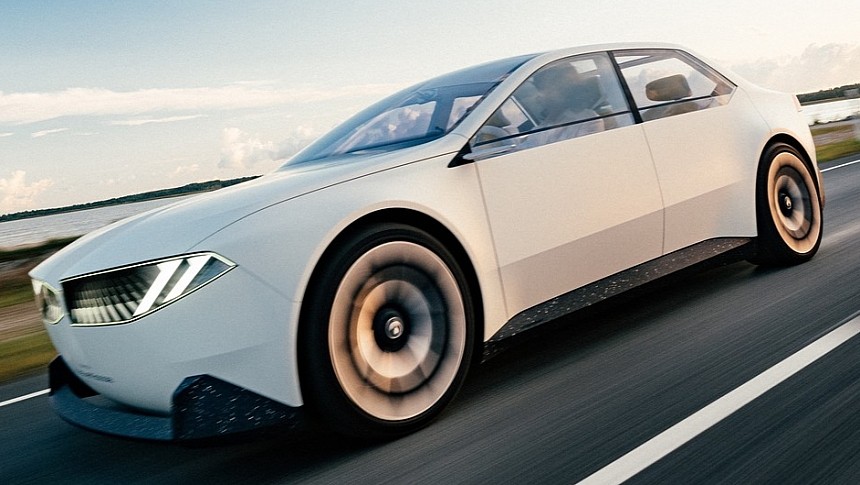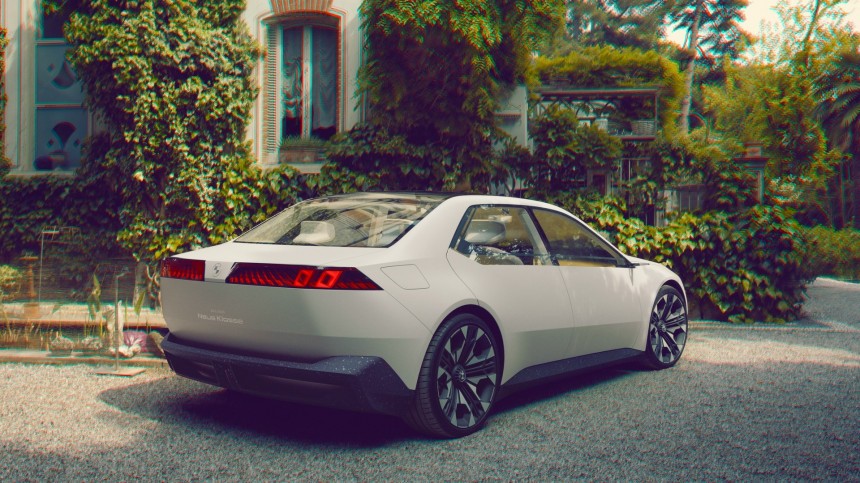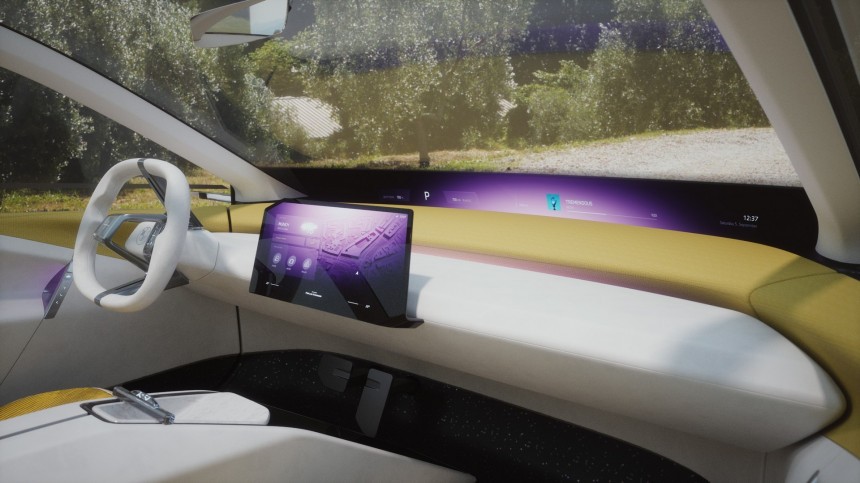It sucks to cover design concepts. The companies that present them usually make long descriptions of curves, surfaces, and proportions that the pictures alone would be more than enough to check. Thankfully, BMW avoided that with the Vision Neue Klasse by adding some bold promises to what we may expect from the production version of this new battery electric vehicle (BEV).
Those who follow what the German carmaker does will find this concept car pretty familiar: it is an updated version of the i Vision Dee, a model that made its premiere at CES 2023. The public gave it a bland reception, which represents a win – considering some of the vehicles BMW has presented lately, such as the iX and the XM. That said, the Vision Neue Klasse is not a head-turner, at least in the pictures BMW shared.
What makes the car interesting is the promise of "30 percent more range, 30 percent faster charging, 25 percent more efficiency." Frank Weber, the member of the Board of Management of BMW responsible for Development, said this at the vehicle's presentation. According to the executive, that's what we should expect from the cars built over this electric architecture. In fact, BMW suggests the very first one will have that name when it starts leaving the Debrecen factory in Hungary. The company did not mention when that should happen this time, but it had already said it wanted that to happen by 2025. Production should occur "entirely without fossil fuels," but the German carmaker did not elaborate on that.
The new electric sedan should be the same size as a 3 Series. BMW believes it will deliver the promises above with "weight, air, and rolling resistance" optimization. In other words, the car will be lighter and more aerodynamic than comparable BEVs. One of the ways to shed weight is "through intelligent heat management, especially for the electric drive train, using sixth-generation BMW eDrive technology."
The most obvious path to achieve these objectives is to count on new battery tech. The German carmaker said the Neue Klasse will use "newly-developed round battery cells, with more than 20 percent higher energy density than that of the prismatic cells previously used." Apart from the higher energy density these cells offer, using cylindrical units is also a massive change for BMW. Ironically, it has to do more with costs than with energy density, which prismatic batteries tend to improve. Tesla has been defending cylindrical cells over prismatic ones for ages – and it is not the only strategy from the American BEV maker that BMW intends to follow.
The German carmaker seems to be proud of the Neue Klasse interior, which you will regard as pretty familiar. Besides the BMW Panoramic Vision, the cabin follows the same ideas Tesla had for the Model 3, such as the central touchscreen. The German automaker calls it the Central Display.
The BMW Panoramic Vision is a head-up display that is projected across the entire base of the windscreen, which allows the passenger to also have information there. My first impression was that it was a display located at that part of the windscreen, but that's not the case.. If it were, the Neue Klasse would have a very expensive windscreen and insurance companies wouk not be happy about it.
As for the drivers, they may get mad at the lack of stalks. Everything will be controlled by the Central Display or buttons on the wheel. Again, Tesla started doing that with the Model S and Model X. The refreshed Model 3 also adopted the idea, but it did not help the Tesla veterans sell more. We'll have to wait for the effects of a stalkless Model 3 because deliveries will only start later this year. The good news for BMW is that it may watch that and reconsider the decision until the Neue Klasse reaches production lines. And it may have to do that.
According to Weber, the new electric car represents "the biggest investment in the company's history." He also said the company is "writing a whole new book" with it. Adrian van Hooydonk, head of BMW Group Design, stated that the vehicle is so progressive that "it looks like we skipped a model generation." These statements show how important this electric 3 Series is for the automaker's future: it may even ditch the naming strategy Bob Lutz helped establish in the 1970s. In other words, the 3 Series may one day be known as the old Neue Klasse.
BMW has to make sure that such a crucial vehicle will strike all the right notes with its buyers. Offering 30% more range, 30% faster charging, and 25% more energy efficiency is certainly a good start. However, is getting rid of stalks a good idea? Are cylindrical cells really the way to go? BMW's new bets are based on what Tesla is doing today. Supposing they work well, one crucial question remains: Will sedans still be as relevant in 2025 as they are today? Several carmakers are ditching them in favor of SUVs. We'll have the answer two years from now, more probably a little later than that.
What makes the car interesting is the promise of "30 percent more range, 30 percent faster charging, 25 percent more efficiency." Frank Weber, the member of the Board of Management of BMW responsible for Development, said this at the vehicle's presentation. According to the executive, that's what we should expect from the cars built over this electric architecture. In fact, BMW suggests the very first one will have that name when it starts leaving the Debrecen factory in Hungary. The company did not mention when that should happen this time, but it had already said it wanted that to happen by 2025. Production should occur "entirely without fossil fuels," but the German carmaker did not elaborate on that.
The new electric sedan should be the same size as a 3 Series. BMW believes it will deliver the promises above with "weight, air, and rolling resistance" optimization. In other words, the car will be lighter and more aerodynamic than comparable BEVs. One of the ways to shed weight is "through intelligent heat management, especially for the electric drive train, using sixth-generation BMW eDrive technology."
The German carmaker seems to be proud of the Neue Klasse interior, which you will regard as pretty familiar. Besides the BMW Panoramic Vision, the cabin follows the same ideas Tesla had for the Model 3, such as the central touchscreen. The German automaker calls it the Central Display.
The BMW Panoramic Vision is a head-up display that is projected across the entire base of the windscreen, which allows the passenger to also have information there. My first impression was that it was a display located at that part of the windscreen, but that's not the case.. If it were, the Neue Klasse would have a very expensive windscreen and insurance companies wouk not be happy about it.
According to Weber, the new electric car represents "the biggest investment in the company's history." He also said the company is "writing a whole new book" with it. Adrian van Hooydonk, head of BMW Group Design, stated that the vehicle is so progressive that "it looks like we skipped a model generation." These statements show how important this electric 3 Series is for the automaker's future: it may even ditch the naming strategy Bob Lutz helped establish in the 1970s. In other words, the 3 Series may one day be known as the old Neue Klasse.
BMW has to make sure that such a crucial vehicle will strike all the right notes with its buyers. Offering 30% more range, 30% faster charging, and 25% more energy efficiency is certainly a good start. However, is getting rid of stalks a good idea? Are cylindrical cells really the way to go? BMW's new bets are based on what Tesla is doing today. Supposing they work well, one crucial question remains: Will sedans still be as relevant in 2025 as they are today? Several carmakers are ditching them in favor of SUVs. We'll have the answer two years from now, more probably a little later than that.












































